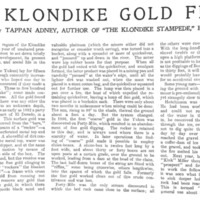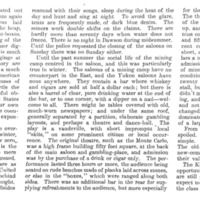"The Klondike Gold Fields" Collier's Weekly, December 1899
Title
"The Klondike Gold Fields" Collier's Weekly, December 1899
Subject
Canadian Gold Exploration
Description
“The Klondike Gold Fields” by Tappan Adney presented information about gold exploration in the Yukon region of northwestern Canada near Alaska which appealed to national and international audiences. Adney was a renowned author and illustrator of naturalist phenomenon, Native people’s culture, and outdoor events. He reported that the initial 1882 discovery of surface gold was “as fine as cornmeal, and was secured from the bars, or low bands of the rivers, by means of a rocker—sort of box-like cradle, with perforated metal top and a blanket set inside at an angle” (Adney 6). The fine gold was placed in a bucket with quicksilver and the produced amalgam was panned at the river’s edge to eliminate dirt and heated to remove quicksilver, “leaving a lump of fine gold” (Adney 6). This procedure changed by 1886 with the discovery of coarse gold, leading to the abandoning of mining for fine gold in favor of using 12’x1’ sluice boxes over the ground to be worked. The severe cold of the region made mining difficult and some miners burned the ground to thaw it enough for digging. After this “drifting” process “the dirt obtained was hoisted out by . . . a crude log windlass” (Adney 7) and set aside until spring thawing. The technical diction used would appeal to more scientific-minded audiences and serve an educational purpose for the less scientific and average reader.
Adney offered a vibrant glimpse into the social life of the Klondike gold fields by using
plain and lively diction to attract the interest of the average reader. According to Adney, the social life of the mining camp revolved around the saloon “where whiskey and cigars are sold at half a dollar each; but there [are] . . . . elaborate gambling layouts, and perhaps a theater and dance hall” (Adney 7). Plays were vaudeville with skits about local figures or events. Admission to the gambling and theater areas of the building was the price of a drink or cigar and following the play was “the grand dance” (Adney 7) where “the dancers were the feminine contingent of the show” (Adney 7) who earned $150 per week plus a twenty-five cent commission for each dance they provided to a miner. The hall “was filled with elbowing crowds of miners, brokers, officials of government, and every condition of man that composes a camp upward of twenty thousand souls” (Adney 7). Clearly, the entrepreneurial spirit present in the mining endeavor resembled Martin Dressler’s drive to succeed and create unique enterprises.
Adney offered a vibrant glimpse into the social life of the Klondike gold fields by using
plain and lively diction to attract the interest of the average reader. According to Adney, the social life of the mining camp revolved around the saloon “where whiskey and cigars are sold at half a dollar each; but there [are] . . . . elaborate gambling layouts, and perhaps a theater and dance hall” (Adney 7). Plays were vaudeville with skits about local figures or events. Admission to the gambling and theater areas of the building was the price of a drink or cigar and following the play was “the grand dance” (Adney 7) where “the dancers were the feminine contingent of the show” (Adney 7) who earned $150 per week plus a twenty-five cent commission for each dance they provided to a miner. The hall “was filled with elbowing crowds of miners, brokers, officials of government, and every condition of man that composes a camp upward of twenty thousand souls” (Adney 7). Clearly, the entrepreneurial spirit present in the mining endeavor resembled Martin Dressler’s drive to succeed and create unique enterprises.
Creator
Tappan Adney
Source
Adney, Tappan. “The Klondike Gold Fields.” Collier’s Weekly: An Illustrated Journal of Art,
Literature and Current Event 30 Dec. 1899: 6-7. Print.
Literature and Current Event 30 Dec. 1899: 6-7. Print.
Publisher
Collier's Weekly
Date
December 30, 1899
Contributor
Gary Guy
Files
Collection
Citation
Tappan Adney, “"The Klondike Gold Fields" Collier's Weekly, December 1899,” Three Decades of NYC, accessed December 13, 2025, http://www.loyolanotredamelib.org/en203/items/show/48.


